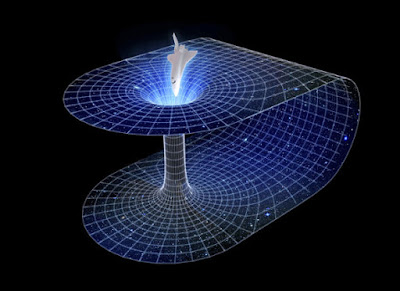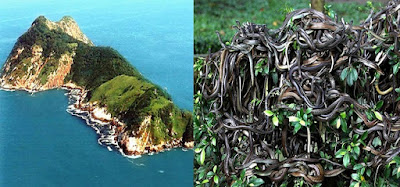Worm Hole (Time Travel)
Like black holes, wormholes arise as valid solutions to the
equations of Albert Einstein's General Theory of Relativity, and, like black holes, the phrase was coined (in 1957) by
the American physicist John Wheeler.
Also like black holes, they have
never been observed directly, but they crop up so readily in theory that some
physicists are encouraged to think that real counterparts may eventually be
found or fabricated.
In 1916, the Austrian
physicist Ludwig Flamm, while looking over Karl Schwarzschild's solution to Einstein's field equations, which describes a
particular form of black hole known
as a Schwarzschild black hole,
noticed that another solution was also possible, which described a phenomenon
which later came to be known as a “white hole”.
A white hole is the theoretical time
reversal of a black hole and, while
a black hole acts as a vacuum, drawing
in any matter that crosses
the event horizon, a white hole acts as a source that
ejects matter from its event horizon. Some have even speculated that
there is a white hole on the
"other side" of all black holes,
where all the matter the black hole sucks up is blown out in some
alternative universe, and even that
what we think of as the Big Bang might
in fact have been the result of just such a phenomenon.
Flamm also noticed that the two solutions, describing two
different regions of space-time could
be mathematically connected by a kind of space-time conduit,
and that, in theory at least, the black hole"entrance"
and white hole "exit"
could be in totally different parts of the same universe or even in different universes! Einstein himself
explored these ideas further in 1935, along with Nathan Rosen, and the two
achieved a solution known as an Einstein-Rosen bridge (also known as a
Lorentzian wormhole or a
Schwarzschild wormhole).
To better visualize a wormhole,
consider the analogy of a piece of paper with two pencil marks drawn on it (to
represent two points in space-time),
the line between them showing the distance from one point to the other in
normal space-time. If the paper
is now bent and folded over almost double (the equivalent of drastically
warping space-time), then poking
the pencil through the paper provides a much shorter way of linking the two
points, a short-cut through space-time much
like a wormhole.
Some theorists are encouraged to think that real
counterparts may eventually be found or fabricated and, perhaps, used as a
tunnel or short-cut for high-speed space travel between distant points or even
for time travel (with all the potential paradoxes that might entail). However, a
generally accepted property of wormholes is
that they are inherently highly unstable and would probably collapse in a much
shorter time than it would take to get through to the other side. At any rate,
it is predicted that they would collapse instantly if even the tiniest amount
of matter (even a single photon) attempted to pass through them.
Although some possible theoretical ways around this
problem have been suggested (for example, using “cosmic strings” or “negative
matter” or some other exotic matter with
“negative energy”) to prevent
the wormhole from
pinching closed, the idea remains largely in the realm of science fiction for
the time being. It has, however, still not been mathematically proven beyond
all doubt that some kind of exotic matter with
negative energy density is an absolute requirement
for wormholes, nor has it been
established that such exotic matter cannot
exist, so the possibility of a practical application of the theory still
remains.
Because a wormholes is
a conduit through 4-dimensional space-time, and not just through space, Stephen Hawking and
others have also posited that wormholes might
theoretically be utilized for travel through time as well as through space,
although it is widely believed that time travel into the past will never be
possible due to the potential for paradoxes and self-destructive feedback
loops.
Schwarzschild Theory
The equations of the theory of general relativity have valid solutions
that contain wormholes. The first type of wormhole solution discovered was
the Schwarzschild wormhole, which
would be present in the Schwarzschild metricdescribing an eternal
black hole, but it was found that it would collapse too quickly for
anything to cross from one end to the other. Wormholes that could be crossed in
both directions, known as traversable wormholes, would only be possible if exotic matter with
negative energy density could be used to stabilize
them.
Schwarzschild wormholes, also known
as Einstein–Rosen bridges (named after Albert Einstein and Nathan Rosen),are
connections between areas of space that can be modeled as vacuum solutions to
the Einstein field equations, and that are now
understood to be intrinsic parts of the maximally extended version of
the Schwarzschild metric describing an eternal
black hole with no charge and no rotation. Here, "maximally extended"
refers to the idea that the space-time should not have any "edges":
it should be possible to continue this path arbitrarily far into the particle's
future or past for any possible trajectory of a free-falling particle
(following a geodesic in the spacetime).
In order to satisfy this requirement,
it turns out that in addition to the black hole interior region that particles
enter when they fall through the event horizon from
the outside, there must be a separate white hole interior
region that allows us to extrapolate the trajectories of particles that an
outside observer sees rising up away from the event horizon.
And just as there are two separate interior regions of the maximally extended
spacetime, there are also two separate exterior regions, sometimes called two
different "universes", with the second universe allowing us to
extrapolate some possible particle trajectories in the two interior regions.
This means that the interior black hole region can contain a mix of particles
that fell in from either universe (and thus an observer who fell in from one
universe might be able to see light that fell in from the other one), and
likewise particles from the interior white hole region can escape into either
universe. All four regions can be seen in a spacetime diagram that uses Kruskal–Szekeres coordinates.
In this spacetime, it is possible to
come up with coordinate systems such that if you pick
a hypersurface of
constant time (a set of points that all have the same time coordinate, such
that every point on the surface has a space-likeseparation,
giving what is called a 'space-like surface') and draw an "embedding
diagram" depicting the curvature of space at that time, the embedding
diagram will look like a tube connecting the two exterior regions, known as an
"Einstein–Rosen bridge". Note that the Schwarzschild metric describes
an idealized black hole that exists eternally from the perspective of external
observers; a more realistic black hole that forms at some particular time from
a collapsing star would require a different metric. When the infalling stellar
matter is added to a diagram of a black hole's history, it removes the part of
the diagram corresponding to the white hole interior region, along with the
part of the diagram corresponding to the other universe.
The Einstein–Rosen bridge was
discovered by Ludwig Flamm in 1916, a few months
after Schwarzschild published his solution, and was rediscovered by Albert
Einstein and his colleague Nathan Rosen, who published their result in 1935. However,
in 1962, John Archibald Wheeler and Robert W. Fuller published
a papershowing
that this type of wormhole is unstable if it connects two parts of the same
universe, and that it will pinch off too quickly for light (or any particle
moving slower than light) that falls in from one exterior region to make it to
the other exterior region.
According to general relativity,
the gravitational collapse of a sufficiently
compact mass forms a singular Schwarzschild black hole. In the Einstein–Cartan–Sciama–Kibble theory of
gravity, however, it forms a regular Einstein–Rosen bridge. This theory extends
general relativity by removing a constraint of the symmetry of the affine
connection and regarding its antisymmetric part, the torsion tensor,
as a dynamical variable. Torsion naturally accounts for the quantum-mechanical,
intrinsic angular momentum (spin)
of matter. The minimal coupling between torsion and Dirac spinors generates
a repulsive spin–spin interaction that is significant in fermionic matter at
extremely high densities. Such an interaction prevents the formation of a
gravitational singularity. Instead, the collapsing matter reaches an
enormous but finite density and rebounds, forming the other side of the bridge.
Although Schwarzschild wormholes are
not traversable in both directions, their existence inspired Kip Thorne to
imagine traversable wormholes created by holding the "throat" of a
Schwarzschild wormhole open with exotic matter(material
that has negative mass/energy).
Other non-traversable wormholes
include Lorentzian wormholes (first proposed by John Archibald
Wheeler in 1957), wormholes creating a spacetime foam in
a general relativistic spacetime manifold depicted by a Lorentzian manifold, and Euclidean
wormholes (named after Euclidean manifold, a structure of Riemannian manifold).
Wormholes (Time Machine)
The Casimir effect shows that quantum field theory allows the energy
density in certain regions of space to be negative relative to the
ordinary vacuum energy, and it has been shown
theoretically that quantum field theory allows states where energy can be arbitrarily negative at
a given point. Many physicists, such as Stephen Hawking, Kip Thorne[ and
others, therefore argue that such effects might make it possible to
stabilize a traversable wormhole. Physicists have not found any natural process
that would be predicted to form a wormhole naturally in the context of general
relativity, although the quantum foam hypothesis
is sometimes used to suggest that tiny wormholes might appear and disappear
spontaneously at the Planck scale, and
stable versions of such wormholes have been suggested as dark matter candidates. It
has also been proposed that, if a tiny wormhole held open by a negative mass cosmic string had
appeared around the time of the Big Bang,
it could have been inflated to macroscopic size
by cosmic inflation.
Wormholes connect two points in
spacetime, which means that they would in principle allow travel in time,
as well as in space. In 1988, Morris, Thorne and Yurtsever worked out
explicitly how to convert a wormhole traversing space into one traversing time
by accelerating one of its two mouths.However,
according to general relativity, it would not be possible to use a wormhole to
travel back to a time earlier than when the wormhole was first converted into a
time 'machine'.
Raychaudhuri's Theorem
To see why exotic matter is
required, consider an incoming light front traveling along geodesics, which
then crosses the wormhole and re-expands on the other side. The expansion goes from negative to
positive. As the wormhole neck is of finite size, we would not expect caustics
to develop, at least within the vicinity of the neck. According to the
optical Raychaudhuri's theorem, this requires a
violation of the averaged null energy condition. Quantum
effects such as the Casimir effect cannot violate the averaged
null energy condition in any neighborhood of space with zero curvature, but
calculations in semiclassical gravity suggest that quantum
effects may be able to violate this condition in curved spacetime. Although
it was hoped recently that quantum effects could not violate an achronal
version of the averaged null energy condition, violations have
nevertheless been found,[33] so
it remains an open possibility that quantum effects might be used to support a
wormhole.
Faster Than Light (Known As Time Travel)
The impossibility of
faster-than-light relative speed only applies locally. Wormholes might allow
effective superluminal (faster-than-light)
travel by ensuring that the speed of light is not exceeded locally at any time.
While traveling through a wormhole, subluminal (slower-than-light) speeds are
used. If two points are connected by a wormhole whose length is shorter than
the distance between them outside the wormhole, the time taken
to traverse it could be less than the time it would take a light beam to make
the journey if it took a path through the space outside the
wormhole. However, a light beam traveling through the wormhole would of course
beat the traveler.
The theory of general relativity
predicts that if traversable wormholes exist, they can also alter the speed of
time. They could allow time travel.[16] This
would be accomplished by accelerating one end of the wormhole to a high
velocity relative to the other, and then sometime later bringing it back; relativistic time dilation would
result in the accelerated wormhole mouth aging less than the stationary one as
seen by an external observer, similar to what is seen in the twin paradox.
However, time connects differently through the wormhole than outside it, so
that synchronized clocks at each mouth will
remain synchronized to someone traveling through the wormhole itself, no matter
how the mouths move around. This means that anything which entered the
accelerated wormhole mouth would exit the stationary one at a point in time
prior to its entry.
For example, consider two clocks at
both mouths both showing the date as 2000. After being taken on a trip at
relativistic velocities, the accelerated mouth is brought back to the same
region as the stationary mouth with the accelerated mouth's clock reading 2004
while the stationary mouth's clock read 2012. A traveler who entered the
accelerated mouth at this moment would exit the stationary mouth when its clock
also read 2004, in the same region but now eight years in the past. Such a
configuration of wormholes would allow for a particle's world line to
form a closed loop in spacetime, known as a closed timelike curve. An object traveling
through a wormhole could carry energy or charge from one time to another, but
this would not violate conservation of energy or charge in each time, because
the energy/charge of the wormhole mouth itself would change to compensate for
the object that fell into it or emerged from it.
It is thought that it may not be
possible to convert a wormhole into a time machine in this manner; the
predictions are made in the context of general relativity, but general
relativity does not include quantum effects. Analyses using the semiclassical approach to incorporating
quantum effects into general relativity have sometimes indicated that a
feedback loop of virtual particles would circulate through
the wormhole and pile up on themselves, driving the energy density in the
region very high and possibly destroying it before any information could be
passed through it, in keeping with the chronology protection conjecture. The
debate on this matter is described by Kip S. Thorne in
the book Black Holes and Time Warps, and a more
technical discussion can be found in The quantum physics of chronology
protection by Matt Visser. There is also the Roman ring,
which is a configuration of more than one wormhole. This ring seems to allow a
closed time loop with stable wormholes when analyzed using semiclassical
gravity, although without a full theory of quantum gravity it
is uncertain whether the semiclassical approach is reliable in this case.
Universal Travel
A possible resolution to the
paradoxes resulting from wormhole-enabled time travel rests on the many-worlds interpretation of quantum
mechanics. In 1991 David Deutsch showed
that quantum theory is fully consistent (in the sense that the so-called density matrix can
be made free of discontinuities) in spacetimes with closed timelike curves.[39] However,
later it was shown that such model of closed timelike curve can have internal
inconsistencies as it will lead to strange phenomena like distinguishing non
orthogonal quantum states and distinguishing proper and improper mixture. Accordingly,
the destructive positive feedback loop of virtual particles circulating through
a wormhole time machine, a result indicated by semi-classical calculations, is
averted. A particle returning from the future does not return to its universe
of origination but to a parallel universe. This suggests that a wormhole time
machine with an exceedingly short time jump is a theoretical bridge between
contemporaneous parallel universes
Because a wormhole time-machine
introduces a type of nonlinearity into quantum theory, this sort of communication
between parallel universes is consistent with Joseph
Polchinski's proposal of an Everett phone (named
after Hugh Everett) in Steven Weinberg's
formulation of nonlinear quantum mechanics.
The possibility of communication
between parallel universes has been dubbed interuniversal travel.




Comments
Post a Comment
Your suggestions